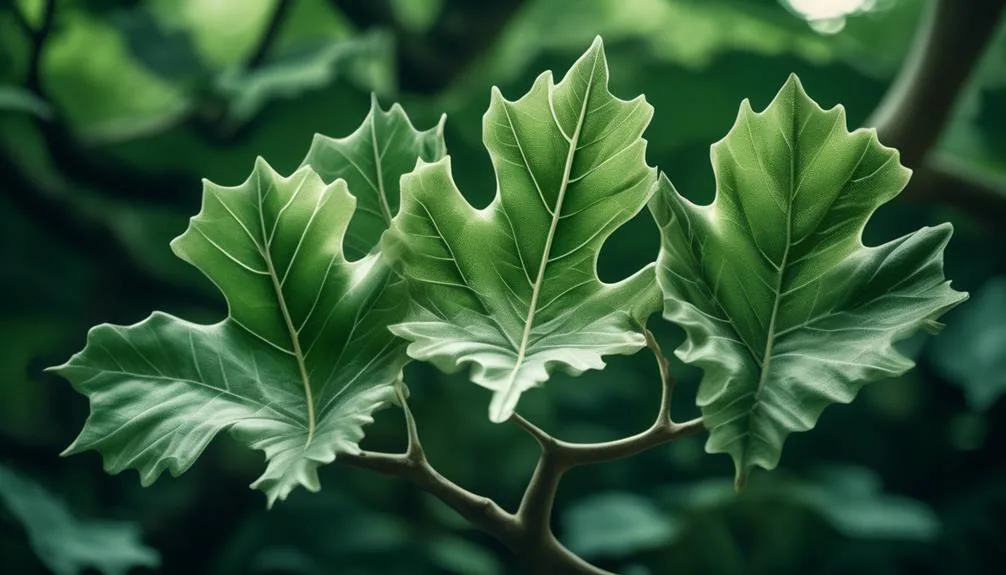Ever stopped to admire the unique shape of sycamore leaves and wondered why they stand out?
These leaves aren't just for looks; they play a crucial role in the life of the sycamore tree.
Exploring the world of sycamore trees and their distinctive leaves reveals remarkable adaptations and evolutionary forces that have shaped these iconic features.
Let's uncover the intriguing story behind the sycamore's distinctive leaves and the mysteries that make them captivating.
Sycamore Tree Leaf Characteristics
Sycamore tree leaves are easily recognizable for their large, broad, and distinctively shaped lobes, adding a unique charm to the tree's overall appearance. The leaf structure of sycamore trees consists of five lobes that create a palmate shape, similar to the outline of a human hand. This distinct feature aids in tree identification, as not many trees have such large, showy leaves with such a specific shape.
The lobes are deep and angular, creating a striking silhouette against the sky. The edges of the leaves are toothed, adding to their allure. When the wind rustles through the foliage, the leaves create a delightful rustling sound, further enhancing the sycamore's appeal. Observing these leaves up close is an excellent way to identify and appreciate the magnificent sycamore tree.
Adaptations for Photosynthesis
With their large, broad, palmate leaves, sycamore trees have developed unique adaptations for photosynthesis, allowing them to thrive in various environmental conditions.
The leaf structure of sycamore trees contributes to their efficient light absorption and photosynthetic processes. The broad, flat surface of sycamore leaves maximizes the exposure to sunlight, optimizing the absorption of light for photosynthesis.
Sycamore leaves have a network of veins that transport water, nutrients, and sugars throughout the leaf, supporting the photosynthetic process and overall health of the tree.
The waxy coating on the leaves helps to reduce water loss and protect the leaf from excessive sunlight, enabling the tree to maintain optimal conditions for photosynthesis.
These adaptations not only ensure the sycamore tree's survival but also contribute to its striking beauty in various landscapes.
Role of Leaf Shape in Sycamore Trees
How does the unique shape of sycamore leaves contribute to their ability to thrive in diverse environments?
Sycamore trees have distinctive leaves with palmate morphology, which means they're deeply lobed and resemble the fingers of a hand. This leaf shape is advantageous for sycamore trees as it allows them to efficiently capture sunlight and maximize photosynthesis.
The large surface area of the leaves enables them to absorb sunlight and carry out the process of converting carbon dioxide into sugars effectively. Furthermore, the lobed structure facilitates the efficient exchange of gases with the environment.
This adaptation to leaf morphology has enabled sycamore trees to carve out a successful ecological niche in various habitats, from riverbanks to urban landscapes. Their ability to thrive in diverse environments is, in part, due to the advantageous shape of their leaves.
Environmental Factors and Leaf Development
Nestled within the rich tapestry of environmental influences, the development of sycamore leaves is a fascinating interplay of factors that shape their unique characteristics.
- Climate Influence: The climate in which sycamore trees grow significantly impacts leaf morphology. From the heat and aridity of a desert to the cool, damp air of a forest, sycamore leaves adapt to optimize photosynthesis and water retention.
- Genetic Predisposition: While environmental factors play a significant role, the genetic makeup of sycamore trees also influences leaf development. Certain genetic traits predispose sycamore trees to produce leaves with specific shapes and sizes.
- Adaptation to Environmental Stress: Sycamore leaves undergo changes in response to environmental stressors such as drought, temperature fluctuations, and nutrient availability. These adaptations ensure the tree's survival in diverse environments while contributing to the distinctive appearance of sycamore leaves.
Evolutionary Origins of Sycamore Leaves
The interplay of environmental factors and genetic predisposition not only shapes the distinctive characteristics of sycamore leaves but also provides valuable insights into their evolutionary origins.
Sycamore trees have a rich evolutionary history, and their leaves have undergone significant changes over time due to genetic variations.
Through the process of natural selection, certain genetic variations that conferred advantages in specific environmental conditions were favored, leading to the development of the unique characteristics observed in sycamore leaves today.
These genetic variations allowed sycamore trees to adapt to diverse habitats and ecological niches, contributing to their widespread distribution.
Understanding the evolutionary origins of sycamore leaves provides a glimpse into the complex interplay between genetic diversity, environmental pressures, and the development of distinct leaf traits in this remarkable species.
Conclusion
In essence, the distinctive leaves of sycamore trees are a testament to their remarkable adaptation for survival and reproductive success.
These leaves, shaped by environmental factors and evolutionary origins, not only contribute to the tree's beauty but also play a crucial role in its overall prosperity.
Their unique characteristics highlight the intricate relationship between form and function in nature, leaving us to ponder the remarkable ways in which tree species thrive in their environments.
Mark Hoffman is a dedicated arborist and tree care specialist with over a decade of experience. His love for trees began when he visited Yosemite National Park as a teenager and was awestruck by the giant sequoias. Mark pursued his passion by studying forestry at Michigan Technological University, where he earned a Bachelor of Science degree.
Since then, he has worked tirelessly in the field of arboriculture, helping to preserve and protect trees in his community. His expertise and dedication have made him a respected leader in the industry and a valuable resource for anyone seeking advice on tree care.
